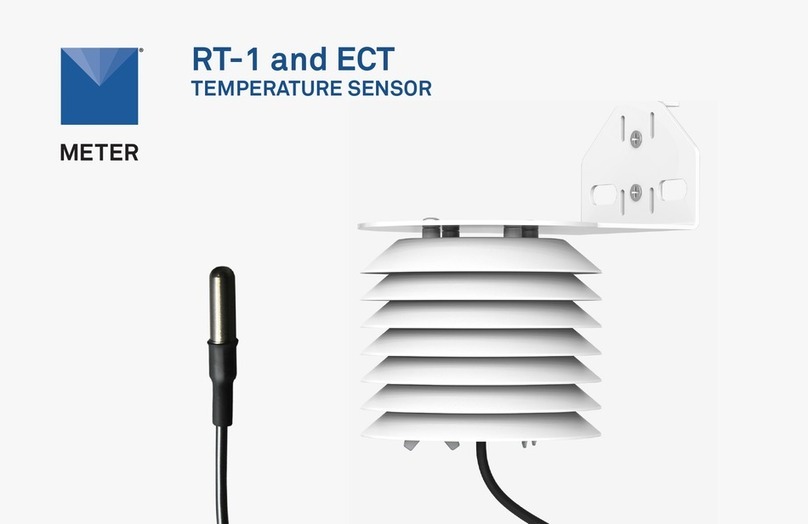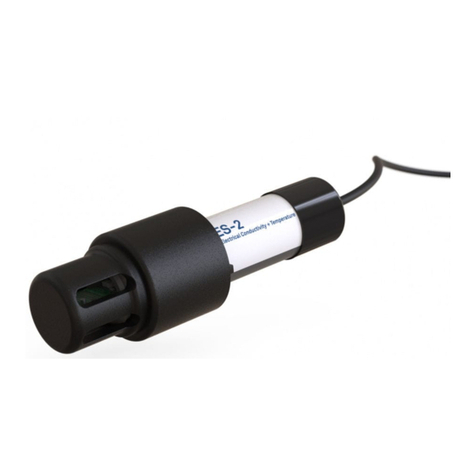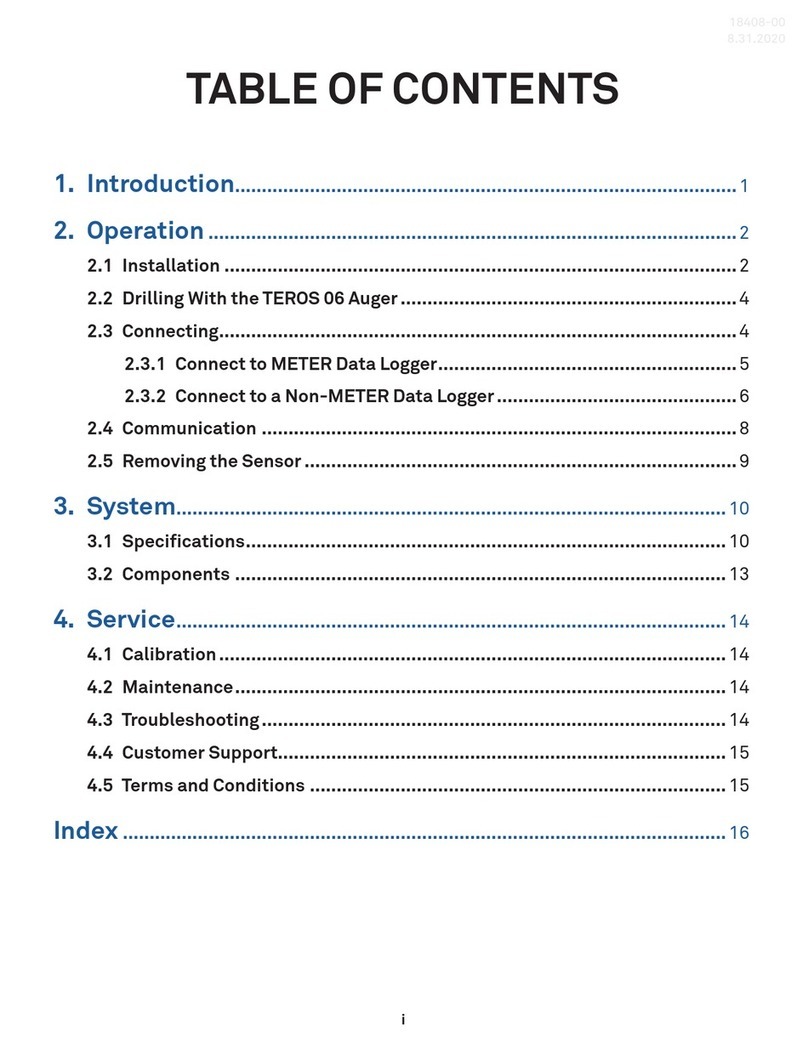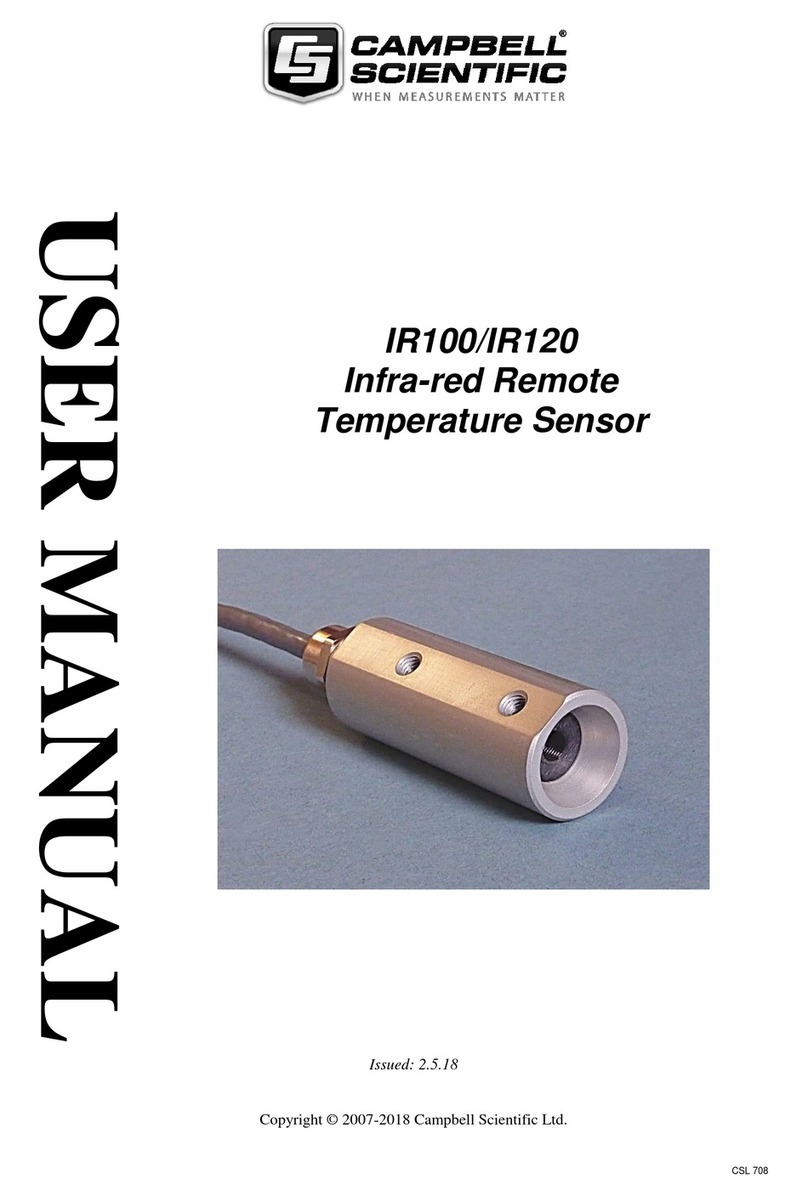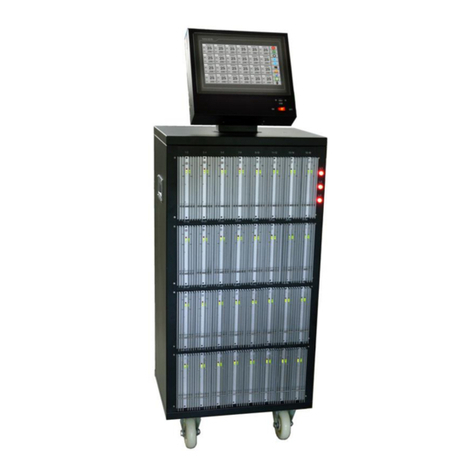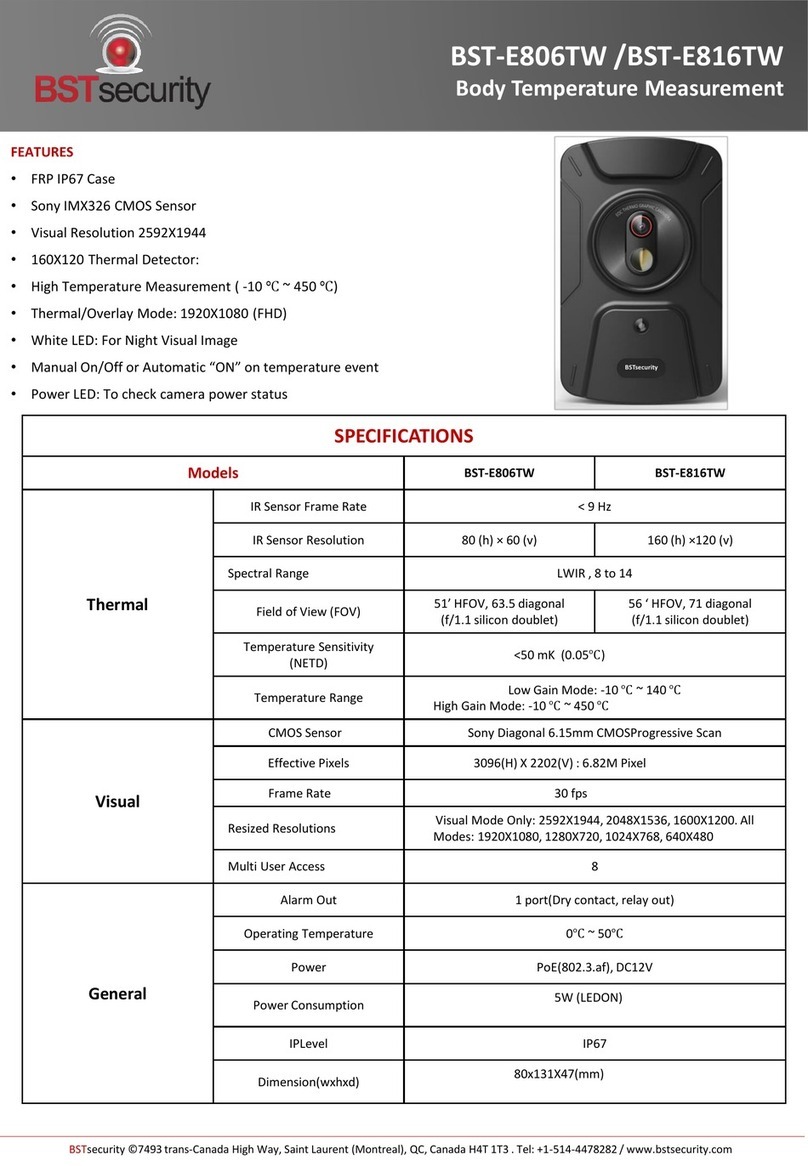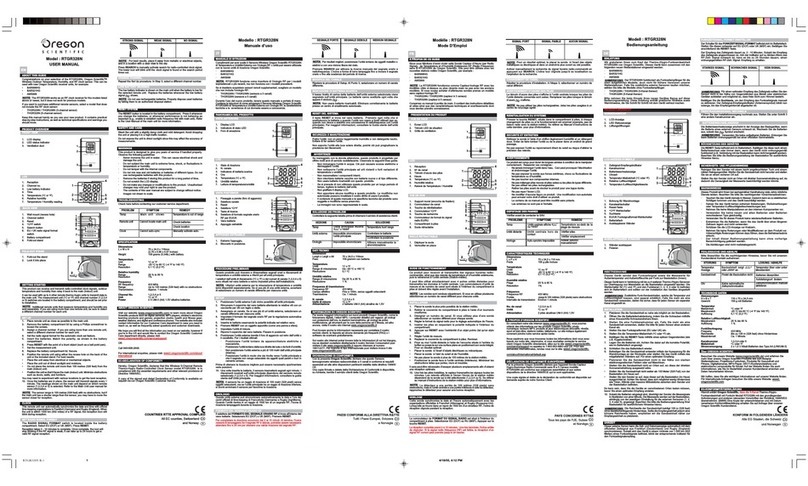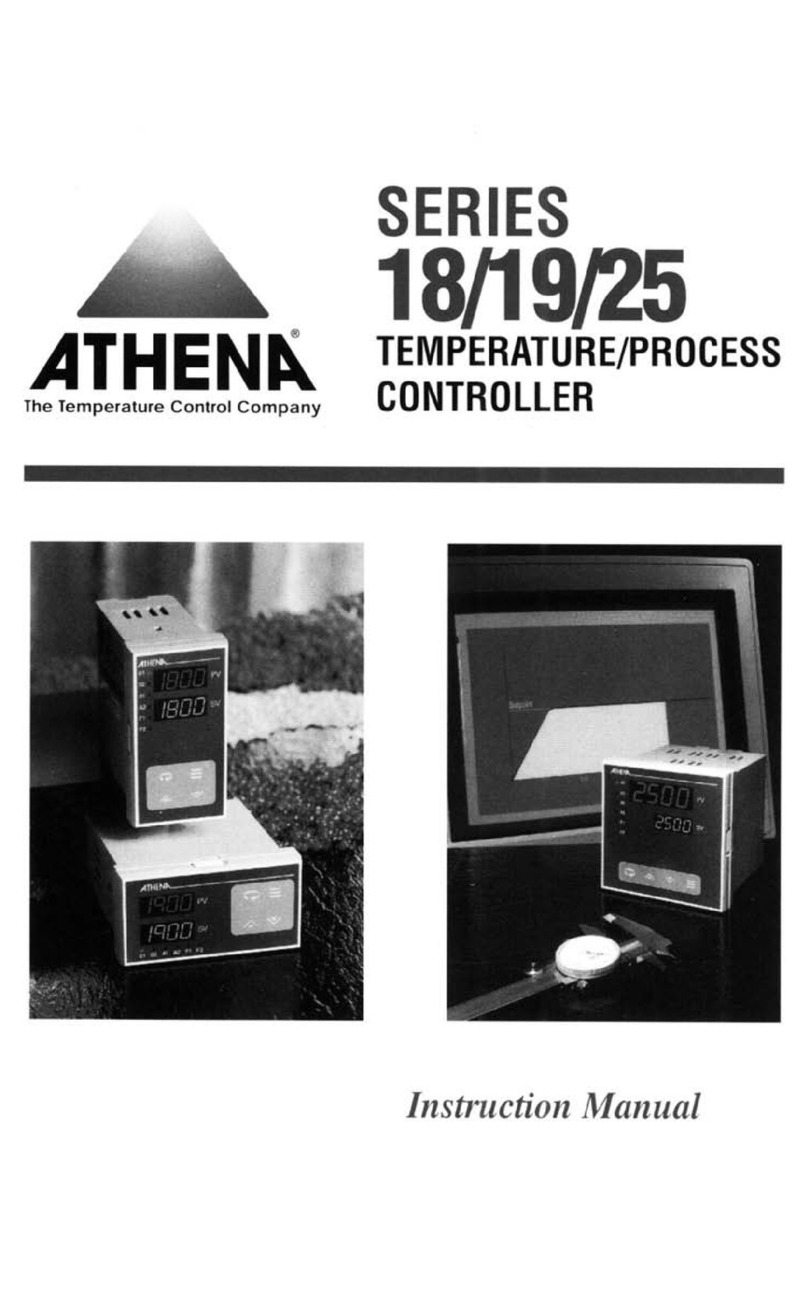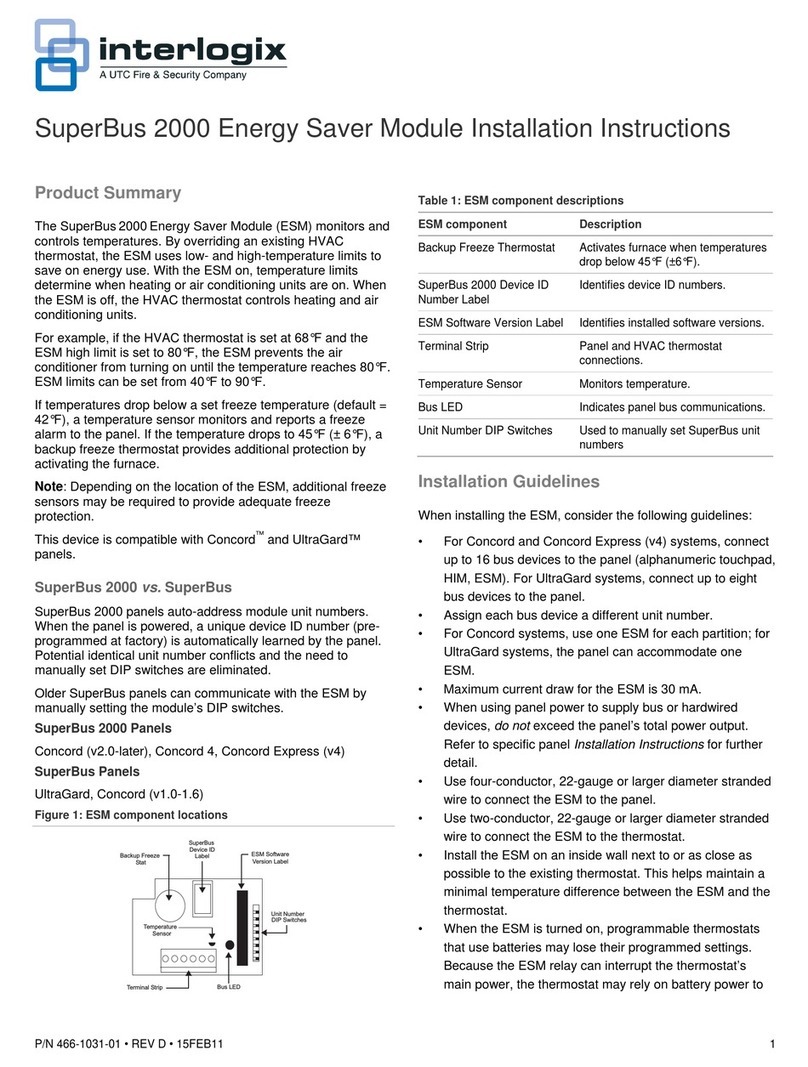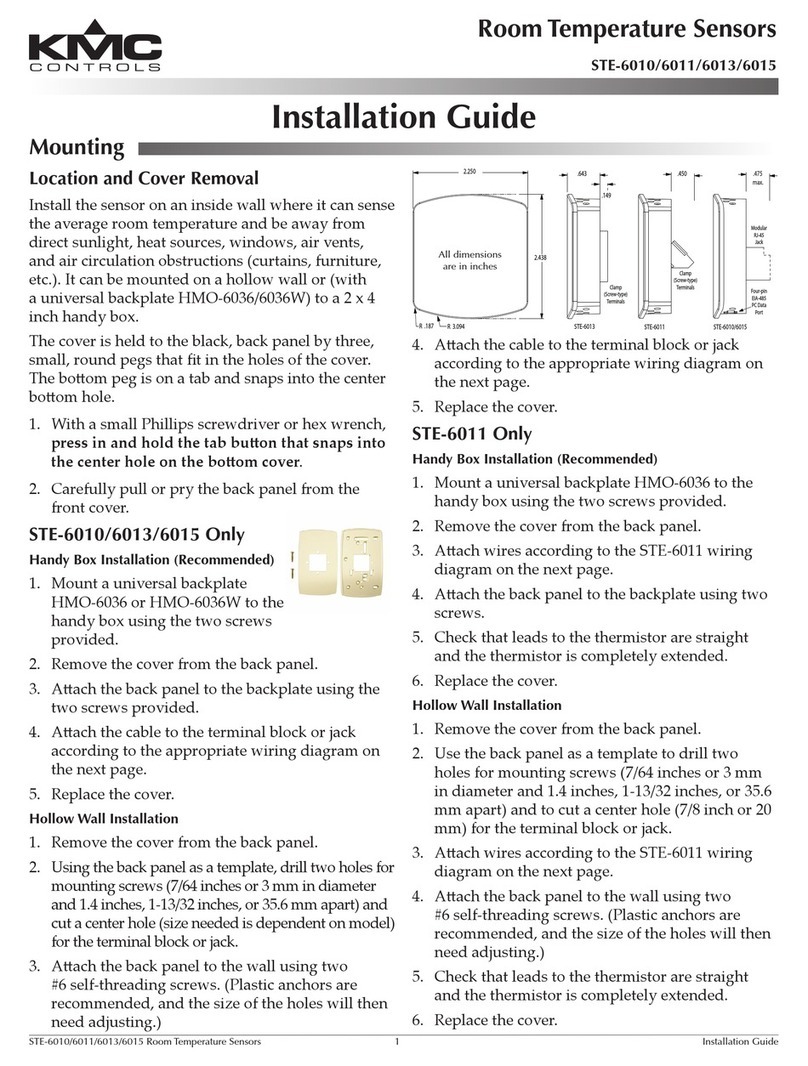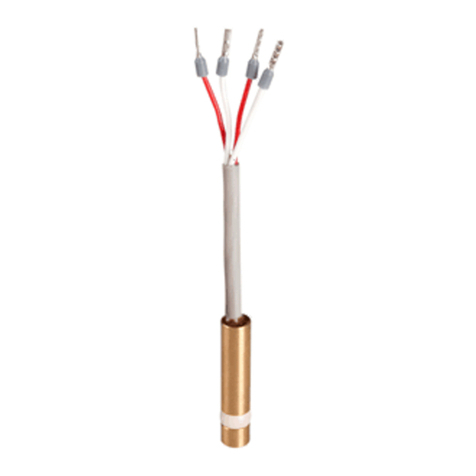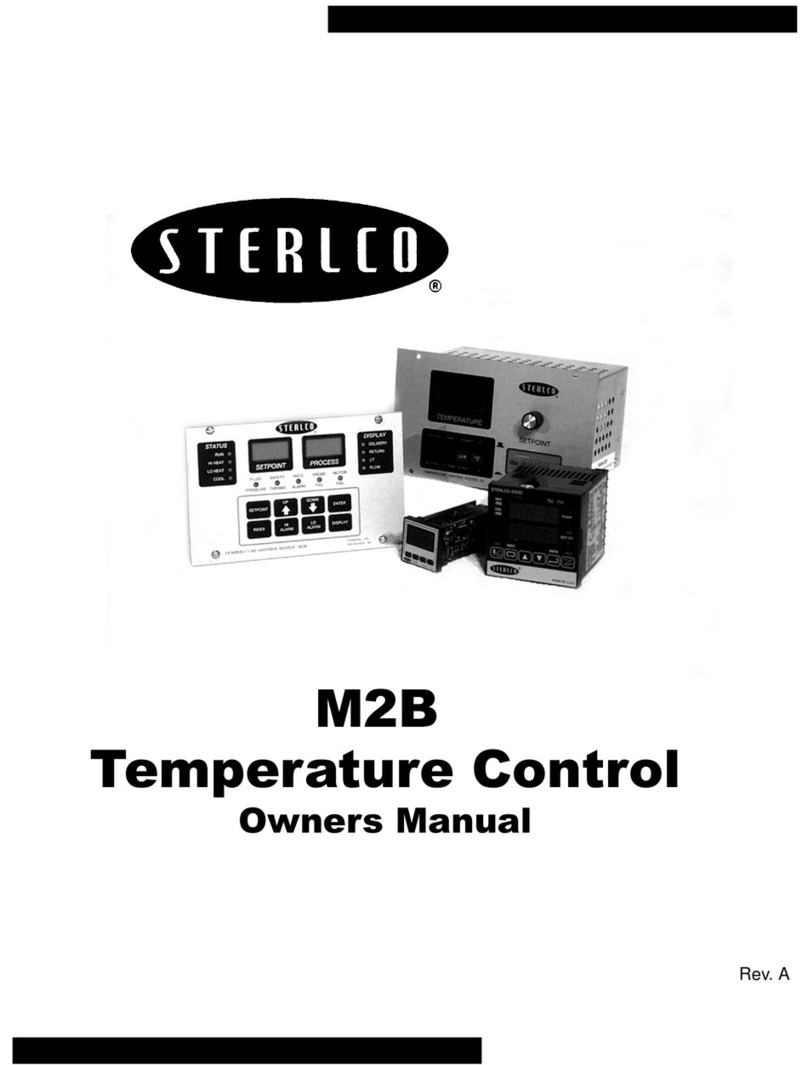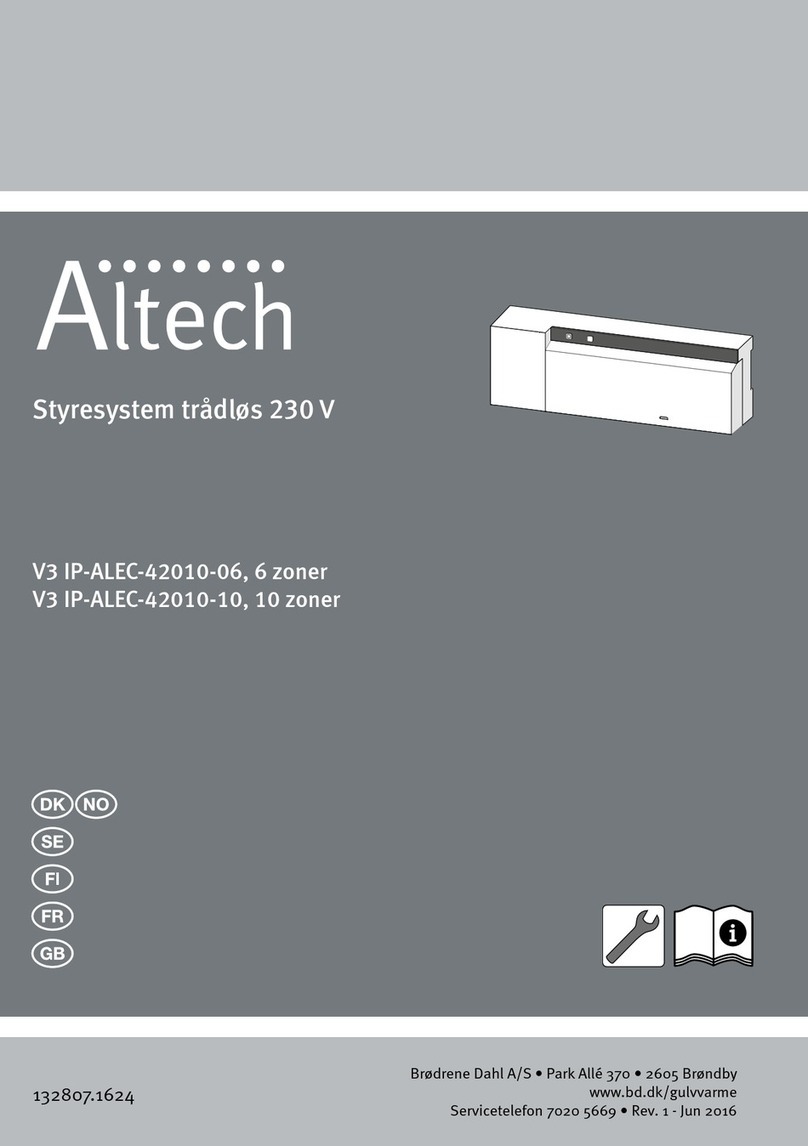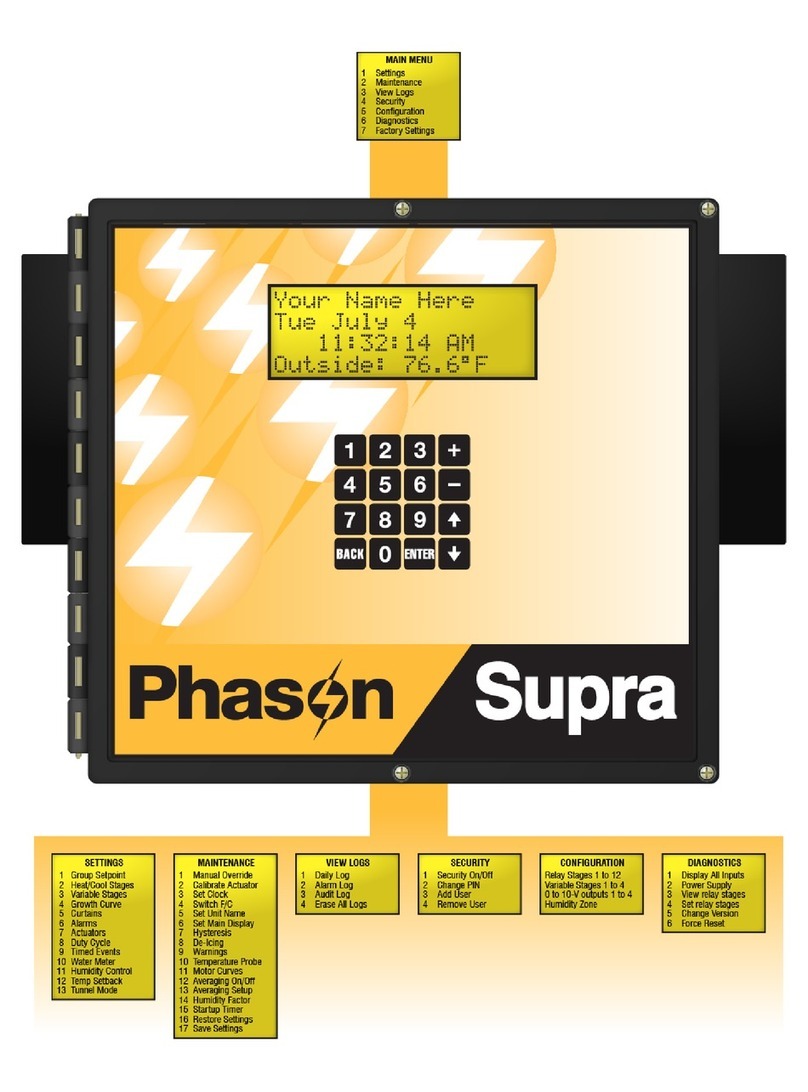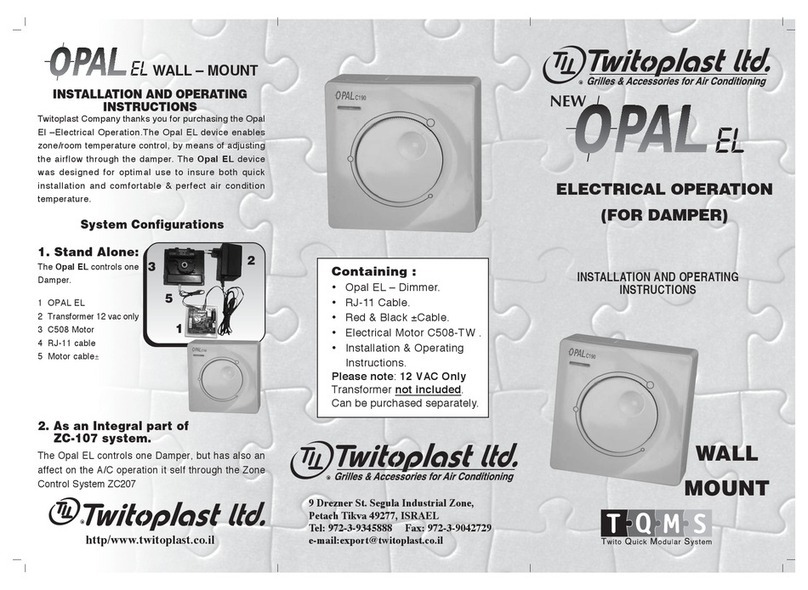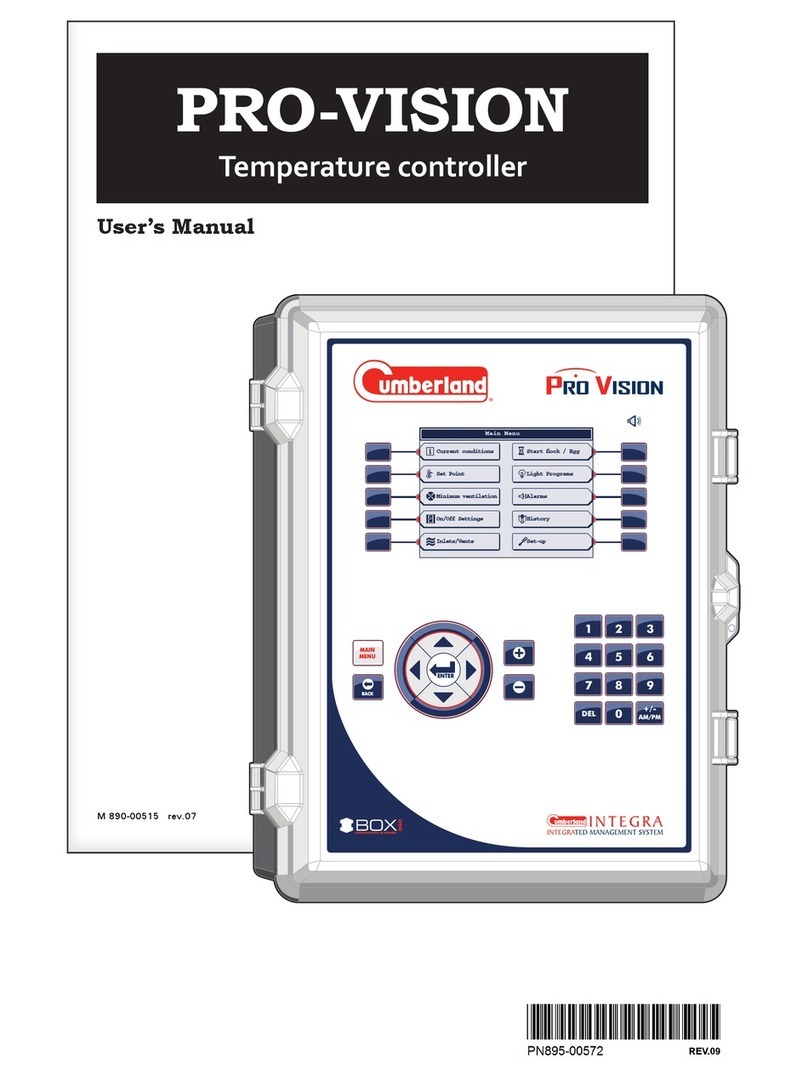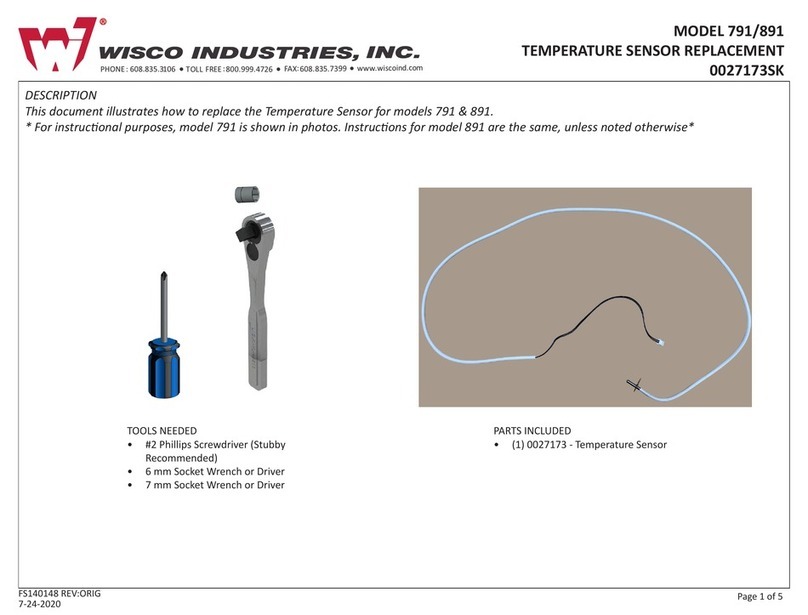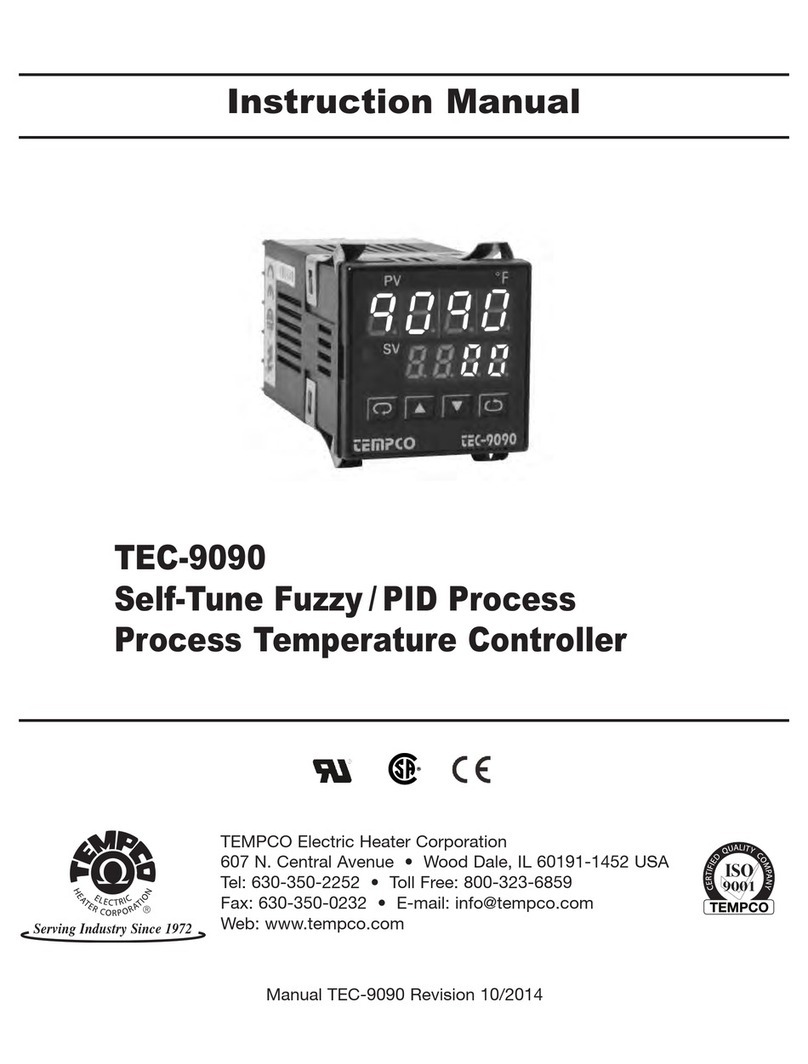METER ES-2 User manual

ES-2

i
TABLE OF CONTENTS
1. Introduction.............................................................................................. 1
2. Operation ...................................................................................................2
2.1 Installation ................................................................................................2
2.2 Connecting................................................................................................. 3
2.2.1 Connect to METER Data Logger........................................................4
2.2.2 Connect to a Non-METER Data Logger .............................................4
2.3 Communication .........................................................................................6
3. System......................................................................................................... 7
3.1 Specifications............................................................................................7
3.2 Components ..............................................................................................9
3.3 Theory...................................................................................................... 10
3.3.1 Temperature .................................................................................. 10
3.3.2 Electrical Conductivity .................................................................. 10
4. Service....................................................................................................... 11
4.1 Calibration ............................................................................................... 11
4.2 Maintenance............................................................................................ 11
4.3 Troubleshooting....................................................................................... 12
4.4 Customer Support.................................................................................... 12
4.5 Terms and Conditions .............................................................................. 13
Index ................................................................................................................. 14
13890-02
4.30.2020


1
1. INTRODUCTION
Thank you for choosing the ES-2 Electrical Conductivity and Temperature Sensor from
METER Group.
The ES-2 sensor measures in an irrigation pipe, a water body, or in a tank. A thermistor in
thermal contact with the probe provides water temperature, while the screws on the surface
of the sensor from a four-electrode array to measure electrical conductivity (EC). EC is useful
for measuring salinity levels or quality of irrigation water.
Prior to use, verify the ES-2 arrived in good condition.

2
OPERATION
2. OPERATION
Please read all instructions before operating the ES-2 to ensure it performs to its full
potential.
PRECAUTIONS
METER sensors are built to the highest standards, but misuse, improper protection, or
improper installation may damage the sensor and possibly void the manufacturer’s warranty.
Before integrating ES-2 into a system, follow the recommended installation instructions and
have the proper protections in place to safeguard sensors from damage.
2.1 INSTALLATION
Follow the steps listed in Table 1 to set up the ES-2 and start collecting data.
Table 1 Installation
Preparation
Determine Installation Type
Decide if the ES-2 will take measurements in a pipe or water body.
Conduct System Check
Plug the sensor into the logger (Section2.2) to make sure the sensor is
functional.
Verify all sensors read within expected ranges. To validate both sensor and
logger functionality, take a sensor measurement in air and water.
Pipe Installation
Connect ES-2 to Pipe
Ensure the protective screw-on cap is attached.
Install the white threaded plug on the side of the protective screw cap.
Screw the the ES-2 into a 3/4-in National Pipe Thread (NPT) Tee pipe fitting.
NOTE: If necessary, use a pipe converter to convert from the 3/4-in NPT thread size to a
size more appropriate for the system.
Orient the sensor with the cable end facing down or to the side. This will allow
air to escape from the sensing area.
Twist sensor into pip fitting

3
ES-2
Table 1 Installation (continued)
Water Body
Installation
Suspend ES-2 in Water Body
Ensure the protective screw-on cap is attached.
Remove the white threaded plug from the side of the protective screw cap.
Suspend the sensor in the tank or water body. If this is not possible, make sure
that the sensor is placed away from the sides of the tank or water body as
much as possible.
Sensor body suspended in water body
Connecting
Secure and Protect Cables
NOTE: Improperly protected cables can lead to severed cables or disconnected sensors.
Cabling issues can be caused by many factors such as rodent damage, driving over sensor
cables, tripping over cables, not leaving enough cable slack during installation, or poor
sensor wiring connections.
Install cables in conduit or plastic cladding when near the ground to avoid
rodent damage.
Gather and secure cables between the ES-2 and the data logger to the
mounting mast in one or more places.
Connect to Data Logger
Plug the sensor into a data logger.
Use the data logger to make sure the sensor is reading properly.
Verify that these readings are within expected ranges.
For more instructions on connecting to data loggers, refer to Section2.2.
2.2 CONNECTING
The ES-2 works seamlessly with METER data loggers. The ES-2 can also be used with other
data loggers, such as those from Campbell Scientific, Inc. For extensive directions on how to
integrate the sensors into third-party loggers, refer to the ES-2 Integrator Guide.

4
OPERATION
ES-2 sensors require an excitation voltage in the range of 3.6 to 15.0 VDC and operate
at a 3.6-VDC level for data communication. ES-2 can be integrated using DDI serial
or SDI-12 protocol. See the ES-2 Integrator Guide for details on interfacing with data
acquisition systems.
ES-2 sensors come with a 3.5-mm stereo plug connector (Figure1) to facilitate easy
connection with METER loggers. ES-2 sensors may be ordered with stripped and tinned
wires to facilitate connecting to some third-party loggers (Section2.2.2).
Ground
Digital communication
Power
Figure1 Stereo plug connector
The ES-2 comes standard with a 5-m cable. It may be purchased with custom cable lengths for
an additional fee (on a per-meter basis). In some instances, the cable can be extended beyond
75 m by the user, but this is discouraged for a variety of reasons. Please contact Customer
Support for more details before extending or splicing cables.
2.2.1 CONNECT TO METER DATA LOGGER
The ES-2 works most efficiently with METER ZENTRA series data loggers. Check the METER
download webpage for the most recent data logger firmware. Logger configuration may
be done using either ZENTRA Utility (desktop and mobile application) or ZENTRA Cloud
(web-based application for cell-enabled data loggers).
1. Plug the stereo plug connector into one of the sensor ports on the logger.
2. Use the appropriate software application to configure the chosen logger port for the
ES-2. METER data loggers will automatically recognize ES-2 sensors.
3. Set the measurement interval.
METER data loggers measure the ES-2 every minute and return the average of the 1-min
data across the chosen measurement interval.
ES-2 data can be downloaded from METER data loggers using either ZENTRA Utility or
ZENTRA Cloud. Refer to the logger user manual for more information about these programs.
2.2.2 CONNECT TO A NONMETER DATA LOGGER
The ES-2 can be purchased for use with non-METER (third party) data loggers. Refer to the
third-party logger manual for details on logger communications, power supply, and ground
ports. The ES-2 Integrator Guide also provides detailed instructions on connecting sensors to
non-METER loggers.

5
ES-2
ES-2 sensors can be ordered with stripped and tinned (pigtail) wires for use with screw
terminals. Refer to the third-party logger manual for details on wiring.
Connect the ES-2 wires to the data logger as illustrated in Figure2 and Figure3, with the
power supply wire (brown) connected to the excitation, the digital out wire (orange) to a
digital input, and the bare ground wire to ground.
Ground (bare)
Digital
communication (orange)
Power (brown)
Figure2 Pigtail wiring
NOTE: Some early ES-2 units may have the older Decagon wiring scheme where the power supply is white, the digital
out is red, and the bare wire is ground.
Excitation Digital
in
Data Logger
Ground
Digital
communication
(orange)
Ground
(bare)
Power
(brown)
Figure3 Wiring diagram
NOTE: The acceptable range of excitation voltages is from 3.6 to 15.0 VDC. To read the ES-2 with Campbell Scientific
data loggers,power the sensors off a switched 12-V port.
If the ES-2 cable has a standard stereo plug connector and needs to be connected to a
non-METER data logger, use one of the following two options.
Option 1
1. Clip off the stereo plug connector on the sensor cable.
2. Strip and tin the wires.
3. Wire it directly into the data logger.
This option has the advantage of creating a direct connection and minimizes the chance of
the sensor becoming unplugged. However, it then cannot be easily used in the future with a
METER readout unit or data logger.

6
OPERATION
Option 2
Obtain an adapter cable from METER.
The adapter cable has a connector for the stereo plug connector on one end and three wires
(or pigtail adapter) for connection to a data logger on the other end. The stripped and tinned
adapter cable wires have the same termination as in Figure3: the brown wire is excitation,
the orange is output, and the bare wire is ground.
NOTE: Secure the stereo plug connector to the pigtail adapter connections using adhesive-lined heat shrink to ensure
the sensor does not become disconnected during use.
2.3 COMMUNICATION
The ES-2 communicates using two different methods:
• DDI serial string
• SDI-12 communication protocol
To obtain detailed instructions, refer to the ES-2 Integrator Guide.
The SDI-12 protocol requires that all sensors have a unique address. ES-2 sensor factory
default is an SDI-12 address of 0. To add more than one SDI-12 sensor to a bus, the sensor
address must be changed as described in these steps.
1. Using a PROCHECK connected to the sensor, press the MENU button to bring up the
Configuration tab.
NOTE: If the PROCHECK does not have this option, please upgrade its firmware to the latest version from the
METER Legacy Handheld Devices webpage.
2. Scroll down to SDI-12 Address. Press ENTER.
3. Press the UP or DOWN arrows until the desired address is highlighted.
Address options include 0...9, A...Z, and a...z.
4. Press ENTER.
Detailed information can also be found in the application note Setting SDI-12 addresses on
METER digital sensors using Campbell Scientific data loggers and LoggerNet.
When using the sensor as part of an SDI-12 bus, excite the sensors continuously to avoid
issues with initial sensor startup interfering with the SDI-12 communications.

7
ES-2
3. SYSTEM
This section describes the specifications, components, and theory of the ES-2.
3.1 SPECIFICATIONS
MEASUREMENT SPECIFICATIONS
Temperature
Range 40 to 60 °C
Resolution 0.1 °C
Accuracy ±1 °C
Bulk EC
Range 0 to 120 dS/m
Resolution 0.001 dS/m
Accuracy ±0.01 dS/m or ±10% (whichever is greater)
COMMUNICATION SPECIFICATIONS
Output
DDI serial or SDI-12 communication protocol
Data Logger Compatibility
METER ZL6 data loggers and any data acquisition system capable of 3.6- to 15-VDC
power and serial or SDI-12 communication
PHYSICAL SPECIFICATIONS
Dimensions
Length 10.9 cm (4.30 in)
Width 2.4 cm (0.95 in)
Thread 1/2-in National Pipe Thread
Operating Temperature Range
Minimum –40 °C
Maximum 60 °C
NOTE: Sensors may be used at higher temperatures under certain conditions; contactCustomer
Supportfor assistance.

8
SYSTEM
Cable Length
5 m (standard)
75 m (maximum custom cable length)
NOTE: Contact Customer Support if a nonstandard cable length is needed.
Connector Types
3.5-mm stereo plug connector or stripped and tinnedwires
ELECTRICAL AND TIMING CHARACTERISTICS
Supply Voltage (VCC to GND)
Minimum 3.6 V
Typical NA
Maximum 15.0 V
Digital Input Voltage (logic high)
Minimum 2.8 V
Typical 3.6 V
Maximum 5.0 V
Digital Input Voltage (logic low)
Minimum –0.3 V
Typical 0.0 V
Maximum 0.8 V
Digital Output Voltage (logic high)
Minimum NA
Typical 3.6 V
Maximum NA
Power Line Slew Rate
Minimum 1.0 V/ms
Typical NA
Maximum NA

9
ES-2
Current Drain (during measurement)
Minimum 20 mA
Typical 20 mA
Maximum 28 mA
Current Drain (while asleep)
Minimum NA
Typical 0.03 mA
Maximum NA
Power Up Time (DDI serial)
Minimum NA
Typical NA
Maximum 100 ms
Power Up Time (SDI-12)
Minimum 100 ms
Typical 200 ms
Maximum 250 ms
Measurement Duration
Minimum NA
Typical 25 ms
Maximum 50 ms
COMPLIANCE
Manufactured under ISO 9001:2015
EM ISO/IEC 17050:2010 (CE Mark)
3.2 COMPONENTS
Thes ES-2 uses four stainless steel electrodes for its conductivity measurement, which
is less sensitive to contamination than a two electrode sensor (Figure4). A thermistor in
contact with the probe provides water temperature. A protective cap helps protect the
electrodes from damage and contamination, and a small plug can be added or removed,
depending on the installation application.

10
SYSTEM
Protective cap
Sensor body
Plug
Figure4 ES-2 sensor
3.3 THEORY
The following sections explain the theory of temperature and electrical conductivity.
3.3.1 TEMPERATURE
A thermistor near the electrical conductivity (EC) sensor senses the temperature of the
water. The sensor uses this temperature to adjust the EC measurements to their 25 C value,
and provides the temperature output for the data stream.
3.3.2 ELECTRICAL CONDUCTIVITY
EC is useful for measuring the concentration of salts in water and also gives information
about dissolved solids. EC is measured by applying an alternating electrical current to two
electrodes, measuring voltage drop with a separate set of electrodes. Then measuring the
current flow through those electrodes and measuring the current with a separate set of
electrodes. The conductance is the ratio of current to voltage. Conductivity is conductance
multiplied by a cell constant based on common conductivity standards. It is important to
realize that a four electrode sensor gives unpredictable readings in air because there is no
connection between the voltage and current electrodes.
ES-2 sensor bulk EC measurements are corrected to EC at 25 °C:
Equation 1
EC25 =
EC
T
1+0.019(T−25)
⎡
⎣
⎤
⎦
where EC25 is the normalized EC at 25 °C, ECTis the EC measured by the probe at temperature
T, and Tis the temperature at the time of measurement.

11
ES-2
4. SERVICE
This section describes the calibration and maintenance of the ES-2. Troubleshooting
solutions and customer service information are also provided.
4.1 CALIBRATION
METER calibrates EC sensors at the factory using potassium chloride (KCl) solutions of
known concentration and calibration values are stored internally in flash memory.
Table 2 relates EC at 25 °C to concentration for various concentrations of KCl. Operators can
verify ES-2 performance using these solutions. The ES-2 internally corrects output value to
25 °C.
Table 2 EC of KCl solutions for testing ES-2 calibrations
Electrical Conductivity
(S/cm)
KCl
(g/kg of distilled water)
100 0.0446
200 0.9300
500 0.2456
1,000 0.5120
2,000 1.0673
5,000 2.8186
10,000 5.8758
20,000 12.2490
4.2 MAINTENANCE
Replacement parts can also be ordered from METER. Contact Customer Support for more
information.
Use the following steps to clean the ES-2.
1. Remove protective cap.
2. Using a sponge and dish soap, scrub the screws until clean.
NOTE: Do not touch the screws without gloves or allow any contact with oil or other nonconducting residue.
3. Clean the cap, if needed.
4. Rinse the sensor and cap thoroughly with tap or DI water.
5. Replace cap.

12
SERVICE
4.3 TROUBLESHOOTING
Table 3 lists common problems and their solutions. If the problem is not listed or these
solutions do not solve the issue, contact Customer Support.
Table 3 Troubleshooting the ES-2
Problem Possible Solutions
Data logger is not
recognizing sensor
If using a METER logger, update logger firmware.
Check the logger configuration for a non-METER data logger using its
user manual.
Check power to the sensor.
Data logger is not receiving
readings from the sensor
Check that the connections to the data logger are both correct and
secure.
Ensure that data logger batteries are not dead or weak.
Check configuration of data logger through software to ensure the
ES-2 is selected.
Ensure the software and firmware is up to date.
Sensor is not responding
Check the sensor was installed correctly.
Check the pressure transducer tube to ensure that it is not clogged
or damaged.
Check sensor cable and connector integrity.
Cable or connector failure
If a stereo plug connector is damaged or needs to be replaced,
contact Customer Support for a replacement connector and
splicekit.
4.4 CUSTOMER SUPPORT
NORTH AMERICA
Customer service representatives are available for questions, problems, or feedback Monday
through Friday, 7:00 am to 5:00 pm Pacific time.
Email: support.environment@metergroup.com
sales.environment@metergroup.com
Phone: +1.509.332.5600
Fax: +1.509.332.5158
Website: metergroup.com

13
ES-2
EUROPE
Customer service representatives are available for questions, problems, or feedback Monday
through Friday, 8:00 to 17:00 Central European time.
Email: support.europe@metergroup.com
sales.europe@metergroup.com
Phone: +49 89 12 66 52 0
Fax: +49 89 12 66 52 20
Website: metergroup.de
If contacting METER by email, please include the following information:
Name
Address
Phone
Email address
Instrument serial number
Description of the problem
NOTE: For products purchased through a distributor, please contact the distributor directly for assistance.
4.5 TERMS AND CONDITIONS
By using METER instruments and documentation, you agree to abide by the METER Group,
Inc. USA Terms and Conditions. Please refer to metergroup.com/terms-conditions fordetails.

INDEX
14
INDEX
A
accuracy 7
C
cable length 8
calibration 11
cleaning 11
compliance 9
components 9–10
connecting
METER data logger 4
non-METER logger 4–5
connector types 8
customer support 12–13
E
electrical conductivity 1, 9, 10, 11
email address 12, 13
F
fax number 12, 13
I
installation 2–3
M
maintenance 11
P
phone number 12, 13
pipe installation 2
protective cap 2, 3, 9
S
specifications 7–10
communication 7
data logger compatibility 7
electrical and timing 8–9
measurement 7
physical 7–8
T
tank installation 3
temperature 1, 7, 9, 10
terms and conditions 13
theory 10
troubleshooting 12

14572-02
4.30.2020
METER Group, Inc. USA
2365 NE Hopkins Court Pullman, WA 99163
T: +1.509.332.2756 F: +1.509.332.5158
E: info@metergroup.com W: metergroup.com
METER Group AG
Mettlacher Straße 8, 81379 München
T: +49 89 1266520 F: +49 89 12665220
E: info.europe@metergroup.com W: metergroup.de
© 2012, 2018, 2020 All Rights Reserved.

Other manuals for ES-2
1
Table of contents
Other METER Temperature Controllers manuals
